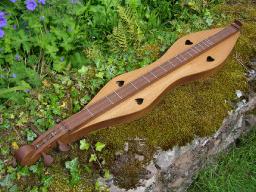Most of the dulcimer builders who grew up in the tradition tuned their instruments for just intonation to sweeten the blending of the melody and drones. Modern dulcimer makers use a different intonation (equal temperament) which blends more readily into triads (3-note chords) to facilitate modern chord melody styles.
The older, traditional "just intonation" gives the most traditional dulcimer sound with the bass and middle drone strings ringing out a constant 1-5 drone against the changing melody. Leonard and Clifford Genn, Edd Presnell, Homer Ledford, A.W. Jeffreys, and a few others continued to use the just tempered scale, and their instruments were made with the drones in mind.
To get one of those sweet sounding "just intonation" instruments like the Glenns made, you need to find one of their instruments in the used marketplace or purchase an instrument from one of a handful of traditional builders. You will find them in the The Traditional Appalachian Dulcimer (TTAD) forum. They build beautiful traditional dulcimers based on the tried and true techniques of the Glenns and others.
Your post is so informative--thank you for posting it.














 I blew the Pics up a bit and I see what your talking about. Boy is my face red.
I blew the Pics up a bit and I see what your talking about. Boy is my face red.
